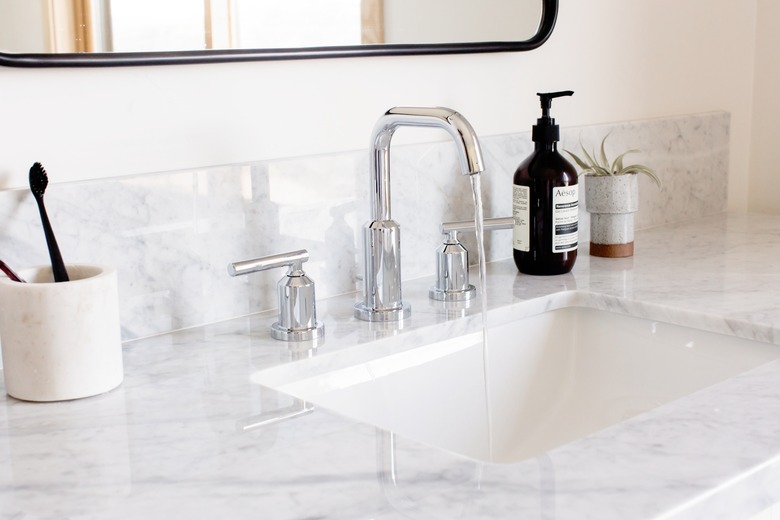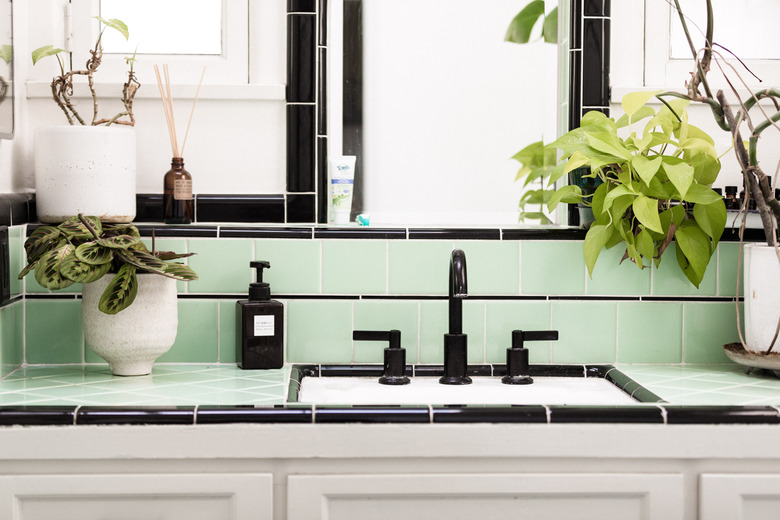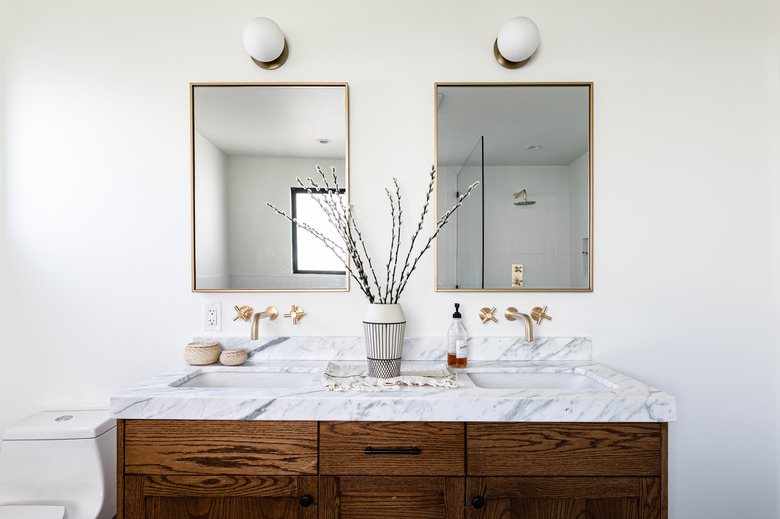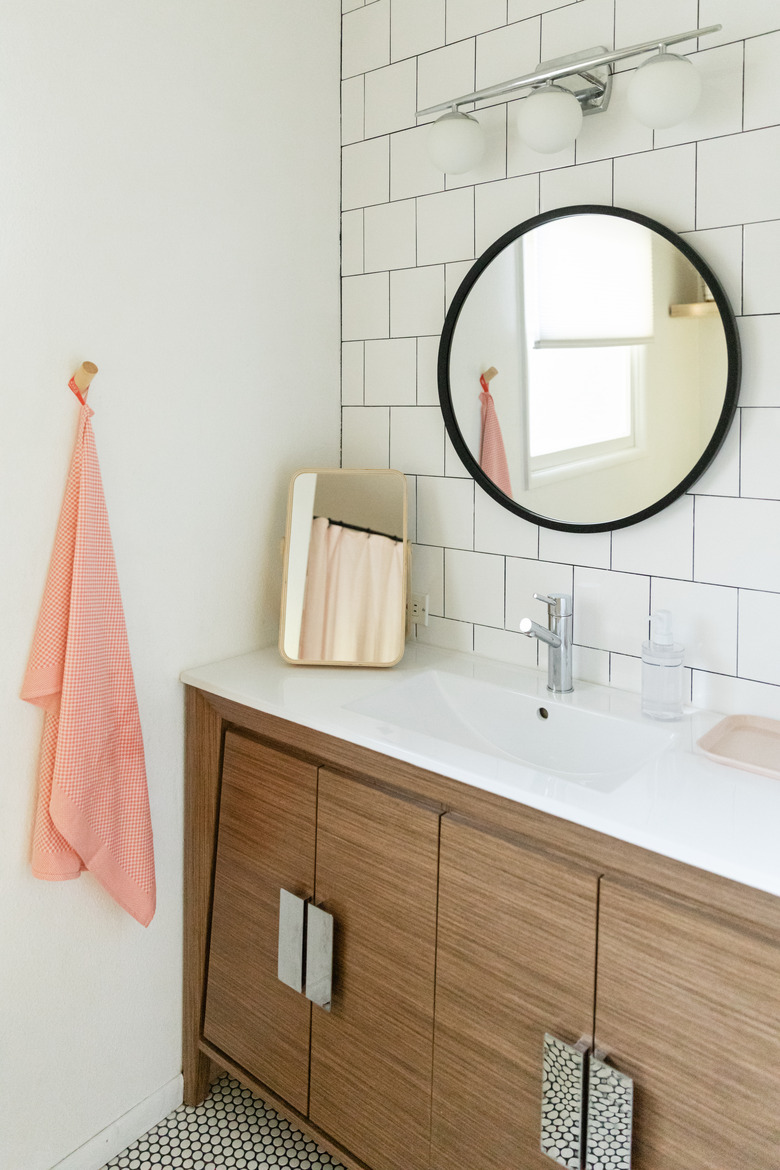The Best Vanity Countertop Materials
According to home improvement professionals, the countertop can comprise 15 to 20 percent of the cost of a kitchen remodel, and it is a similarly big part of a bathroom remodel, where the choice of vanity countertop is crucial. Because of the expense, the emphasis is sometimes on economy when it comes to choosing a material for the bathroom vanity. But the square footage of a bathroom vanity countertop is much less than it is for a kitchen countertop, and some homeowners take this as motivation to treat themselves to a more luxurious material for the bathroom countertop.
Considering which vanity countertop material to choose for your bathroom remodel? Here's a guide to selecting the best for your bathroom.
What Are the Best Vanity Countertop Materials?
Choosing the best countertop materials is difficult since individual choices will depend entirely on your budget and design preferences. For one homeowner, a very inexpensive post-form laminate countertop will be best, while for another, only a countertop made of trendy and expensive recycled glass will meet the grade. According to a survey by Home Stratosphere, the countertop materials that are most often recommended by professionals include:
- Granite
- Quartz (engineered stone)
- Marble
- Solid surface
- Concrete
- Tile
- Laminate
- Recycled glass
- Butcher block
- Stainless steel
- Reclaimed wood
- Porcelain
- Lava
- Resin
- Bamboo
However, popularity among professional designers by no means translates to the "best" vanity countertop for most homeowners. What designers recommend for a bathroom countertop is often governed by current trends, and this often ignores the realities of how the material performs and does not take into account the fact that design trends can quickly change. Most homeowners will want to limit their choice to a vanity countertop material that has a timeless visual appeal and offers excellent performance for the wet environment of a bathroom.
The best choices for materials that meet these criteria for bathroom vanity countertops include laminate, solid surface, ceramic or porcelain tile, engineered stone (often known as quartz), natural stone and porcelain.
Laminate Vanity Countertops
Laminate countertops are built by bonding a thin layer of plastic laminate material to a core of particleboard using contact cement. They can be purchased as post-form countertops with rolled front edges and short backsplashes attached, or they can be custom built to size using any one of thousands of different patterns and colors available. Big-box home improvement centers usually sell small post-form vanity countertops in sizes to match standard vanities. Custom-built countertops are fabricated by professionals, who can create specialized backsplashes and edge treatments.
Laminate countertops are best suited for drop-in sinks. DIYers find post-form laminate countertops very easy to install, and even custom fabrication of a laminate vanity top is relatively simple for a DIYer with moderate experience.
Laminate countertops have good resistance to water and stains. Costing $10 to $40 per square foot when fabricated and installed by pros, this is an excellent countertop material for DIYers or homeowners seeking to economize. While laminate countertops do not have the prestige of other countertop materials, newer high-pressure laminates are well regarded. This is a good countertop material for family baths or guest baths, but you might want to use a more upper-end material in a master bath.
Solid-Surface Countertops
Solid-surface material is made from a blend of minerals and acrylic and polyester resins. These are sometimes known as resin countertops. At $45 to $75 per square foot for fabrication and installation, they are more expensive than laminate countertops, but they have still greatly cut into the market share of laminates as an affordable material for vanity countertops.
The main advantage of solid surface is that the material is solid from top to bottom through its entire thickness; there is no wood-based core material that can get wet or swell up. Solid-surface countertops are well-suited for most sink styles: drop-in, undermount or vessel sinks. Countertops made from solid surface are normally fabricated on-site, a process not really possible for DIYers, but there are also small vanity countertop sections with precut sink holes that can be purchased and installed by DIYers. Solid-surface countertops are sometimes integrated with sink basins already built in or with undermounted basins already attached.
Solid-surface material can be scratched and stained, but blemishes are generally easy enough to scrub or sand out with abrasives. This is an excellent countertop material for any bathroom, though it doesn't have the prestige of natural stone or quartz.
Ceramic or Porcelain Tile Countertops
A traditional countertop material is clay-based ceramic tile — the same material that covers the floors in many bathrooms and kitchens. These countertops are built by starting with a plywood or particleboard countertop core, covering it with cementboard underlayment and then cutting the openings necessary for the sink and faucet. Ceramic, porcelain or sometimes stone tile is then bonded to the cementboard using thinset adhesive. The joints between tiles are filled with a mortar-based grout, which is then sealed to protect it from water and stains.
Unlike other countertops, tile countertops are usually fabricated right in place, built atop a vanity cabinet that is already installed. They are most suitable for drop-in sinks. A major advantage to tile countertops is that they are fairly easy for DIYers to fabricate. A DIY tile countertop can be one of the most affordable, ranking second only to laminate countertops for expense. The materials run from $5 to $10 per square foot for tile. This is only true of a DIY countertop because the work is labor intensive, and a professionally installed countertop costs about double that of a DIY job — $15 to $20 per square foot.
Thousands of different tile options exist, so design options are nearly unlimited when it comes to a tile countertop. While the tile itself is completely waterproof, the grout lines can trap water and are subject to staining. Tile countertops are no longer as popular as they once were, but they are still an excellent choice for DIYers.
Engineered Stone (Quartz) Countertops
Engineered stone, often called quartz, is a newer product that owes its parentage to an older material — cultured marble. Engineered stone is made of real stone, mostly ground quartz, bonded together with polyester resins and shaped into various shapes and sizes. (Cultured marble was made from finely ground stone dust.) Engineered stone countertops can be remarkably convincing stand-ins for marble or granite but with many more colors and styles available. Unlike natural stone, this material is uniform throughout and is not susceptible to the flaws and cracks that can occur with natural stone.
These countertops are somewhat expensive at $40 to $100 per square foot installed, but they are gradually becoming a very popular choice for creating a luxury look in bathrooms. Engineered stone may be too expensive to use extensively, but it can be an excellent choice for a master bathroom. These countertops are ordered prefabricated to your specifications. While installation is not difficult, these countertops are very heavy, and DIYers must make sure to have help to move and install them. Professional installation is more common.
Natural Stone Countertops
This broad category includes countertops made from earth minerals quarried from the earth and cut into slabs for use as countertops. The most common forms of stone used for countertops are granite, slate, marble, soapstone, limestone/travertine and lava. Each form of stone has some advantages and disadvantages, but overall, these will be rather expensive countertops, costing $40 to $150 per square foot.
The principle advantage of natural stone as a countertop material is that each countertop is unique, reflecting the patterns and colors of the stone as found in its particular quarry. Natural stone countertops are easily recognized as such, and they invariably add real estate value to a home. Natural stone requires care since some types of stone are quite porous and must be regularly sealed against water and stains. Natural stone can have structural flaws that lead to cracks, and it is quite difficult if not impossible to repair.
Porcelain Vanity Countertops
The same porcelain material commonly used for sinks, toilets and other bathroom fixtures can also be used for entire countertop units. Porcelain is a semi-translucent, vitreous china material made from fine clays fired by heat. Porcelain is naturally white, but pigments added to the formulation can give it solid colors. These have been very popular in Europe for years and are gradually making inroads in the United States market.
The main advantage to porcelain is that it is a very hard, impervious, stain-resistant material that is completely unaffected by chemical cleaners. These countertops are stronger than granite yet weigh less. They can be a good choice for modern Euro-design bathrooms. Costs range from $60 to $100 installed.
Other Countertop Materials to Consider
- Cultured marble: This early form of synthetic stone was made from finely ground limestone powder mixed with coloring agents and synthetic resins. You can still buy these countertop units off the shelf at home improvement centers, often integrated with sink basins that are built in. Cultured marble is now considered a low-end countertop that doesn't add real estate value, and the material is susceptible to cracking, especially around the drain opening. They are also susceptible to heat damage, but a cultured marble countertop can be a good choice for seldom-used bathrooms. Costs range from $30 to $100 per square foot, but remember that the sink basin is usually built into the countertop, so you will save on that cost.
- Concrete: A trendy option is a vanity countertop made from poured and polished concrete. At $60 to $120 per square foot installed, this is an expensive option but one that creates a very modern-looking, unique countertop. Trendiness aside, these countertops have a number of drawbacks. Concrete can develop cracks, and it requires regular resealing to protect it from staining. Good fabricators can be hard to find, and these countertops are extremely heavy and virtually impossible for DIYers to fabricate and install.
- Wood: Countertops made from butcher block or reclaimed wood are very trendy. They cost $40 to $100 per square foot installed. While wood makes for a very unique look for a vanity countertop, it is one of the least-successful materials for use in wet environments. Unless it is carefully and repeatedly sealed, it will quickly develop water stains and damage.
- Bamboo: The same bamboo material that is increasingly popular for floors can also be used on countertops. Bamboo makes for a very unique countertop, but like wood, the material is not very moisture-resistant. Costs are typically $40 to $100 per square foot installed.
- Recycled glass: At $60 to $120 per square foot installed, this is a high-end countertop that can be right if you're looking for something unique. Styles vary widely, and some qualify as true art pieces. A major advantage is that these countertops are largely made from post-manufactured, recycled glass; they appeal to environmentally conscious homeowners. Of the "also-ran" choices for a vanity countertop material, this is one of the best.
- Stainless steel: This material is a good choice when you are seeking a retro or contemporary look for the room, but it looks out of place with other decor styles. This is one of the most sanitary choices for a vanity countertop since its nonporous surface is very easy to clean. This is a fairly expensive choice, costing at least $80 per square foot.
- Lava: Lava countertops are literally made from lava stone quarried from sites of ancient volcanic eruptions. They must be ordered prefabricated to your specifications, and part of the fabrication process is to glaze and fire it to create a smooth, impervious surface in whatever color you choose. The cooling process creates a network of tiny cracks in the glazed surface, a process called crazing, which gives every vanity countertop a unique look. These are very expensive countertops at $250 to $300 per square foot, but they make for a truly unique bathroom countertop.



